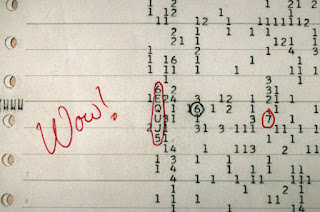Interstellar Objects
The vast majority of space is empty. However, gravitationally clusters of objects can form. For instance, the main asteroid and Keiper belts are clusters of objects that orbit the inner and outer solar system respectively. The objects that exist within these belts range from small microscopic ices to large macroscopic chunks.
Due to its size and mass, everything contained within our solar system is gravitationally bound to the sun. The gravitational field associated with small or large object interact with the sun to form a stable circular orbit. In accordance with Newtonian mechanics this effect is more prominent with larger planetary objects then that of smaller particle sized objects.
This gravitational attraction from the sun is large, but not infinite. At distances of up to 3.2 light years from the sun the gravitational bind is no longer felt. At these distances a final layer of objects are located and surround our star. This is called the Oort cloud:
 |
| Much like Earth, the Oort cloud is gravitationally bound to the sun and it is the final layer of objects experiencing a gravitational attraction. |
Unlike the inner planets of the solar system (including Earth) which possess circular orbits, comets display elliptical orbits given their enormous distance from the sun. However, comets are travelling slow enough and remain gravitationally bound to our sun. With remarkable accuracy Newtonian physics can be used to predict the orbital periodicity of comets.
Very recently, interstellar objects have appeared within our solar system. These are objects that have originated from beyond the Oort cloud and are considered interstellar. We know these objects are interstellar in nature because their orbits are highly elliptical and they travel at faster speeds, this means they are not gravitationally captured by our sun:
 |
| The orbital differences between stellar and interstellar objects, a) Comet, b) 'Oumuamua and c) Comet Borisov. |
In 1705 astronomer and mathematician Edmond Halley used Newtonian physics to predict the periodicity of a regular comet. He predicted it to return in 1758 with a orbital periodicity of 75-76 years. Ironically whilst Halley wasn't alive to witness his accurate prediction, the comet appeared in the sky of Christmas day that year, it would have been Isaac Newtons 116th birthday.
In 2017 interstellar object 1I/2017 UI ('Oumuamua) was detected passing through our solar system, it was discovered by astronomer and physicist Robert Weryk. By the time it was discovered 'Oumuamua had already passed the sun and is now headed back into interstellar space. It's orbital eccentricity and non-gravitational acceleration was characteristic of an interstellar object. This means that 'Oumuamuas gravitational field is bent by our sun but cannot be captured.
Additionally in 2019, another interstellar object C/2019 Q4 (Comet Borisov) was detected at a much earlier point to that of 'Oumuamua. It was discovered by amateur astronomer Gennadiy Borisov with a modified telescope. Whilst Comet Borisov had more non-gravitational acceleration and a much larger orbital eccentricity than that of 'Oumuamua making it also interstellar in nature, it passed slightly further away from the sun meaning its exit trajectory from our solar system is different.
As Halley's comet is gravitationally bound to our sun it is periodic and can therefore be studied. However, 'Oumuamua and Comet Borisov are not, this makes them baffling to astrophysicists about their possible origins.
For 'Oumuamua many suggest that the non-gravitational velocity emanates from hydrogen ice believed to be present on the asteroid. This would have sublimated upon coming closer to the sun thus acting as a propellent. This mass loss would also explain the shape of the asteroid which was reported as cigar like. Although other radical ideas suggest the shape to be artificial in nature with 'Oumuamua acting a solar sail propelled by solar radiation pressure. Although this theory is disliked by many.
For Comet Borisov, the most likely explanation is that this comet existed just outside our Oort cloud or on the peripheral interface between the Oort cloud and interstellar space. This is because Comet Borisov exhibited similar visible light spectra properties and surface chemistry to that of periodic Oort cloud comets such as Halley's Comet.







Comments
Post a Comment